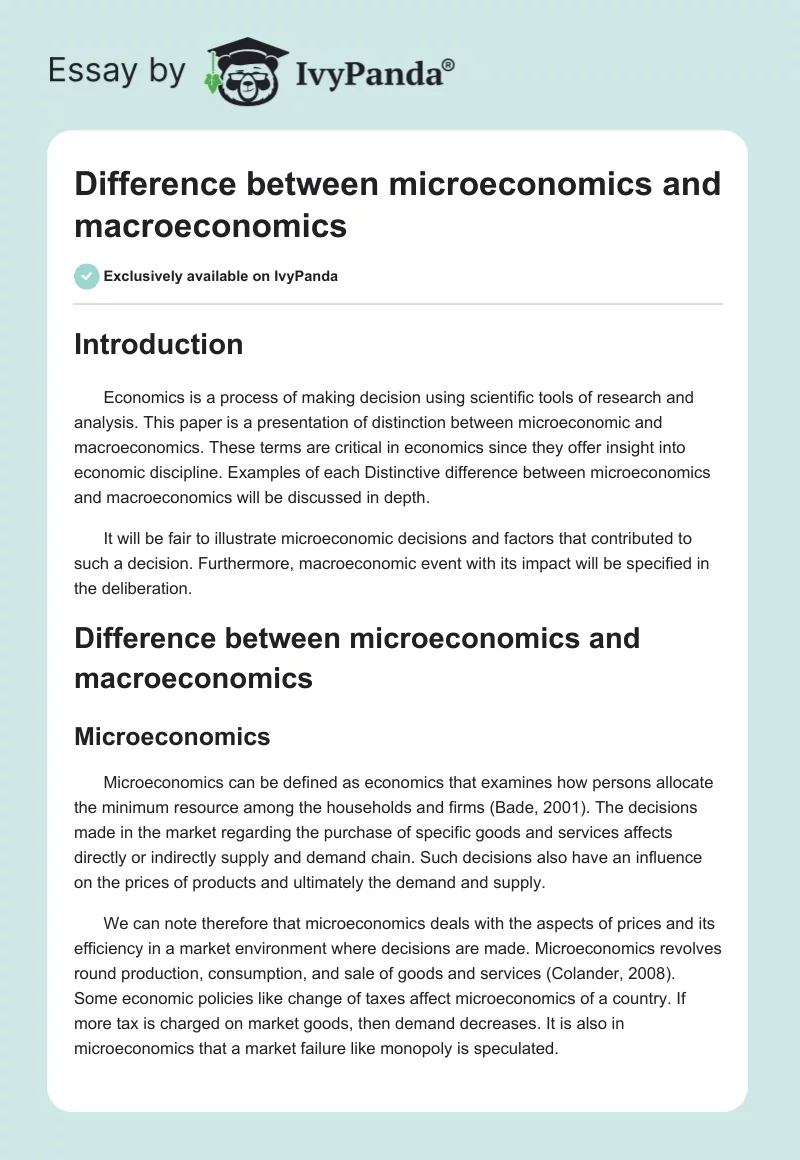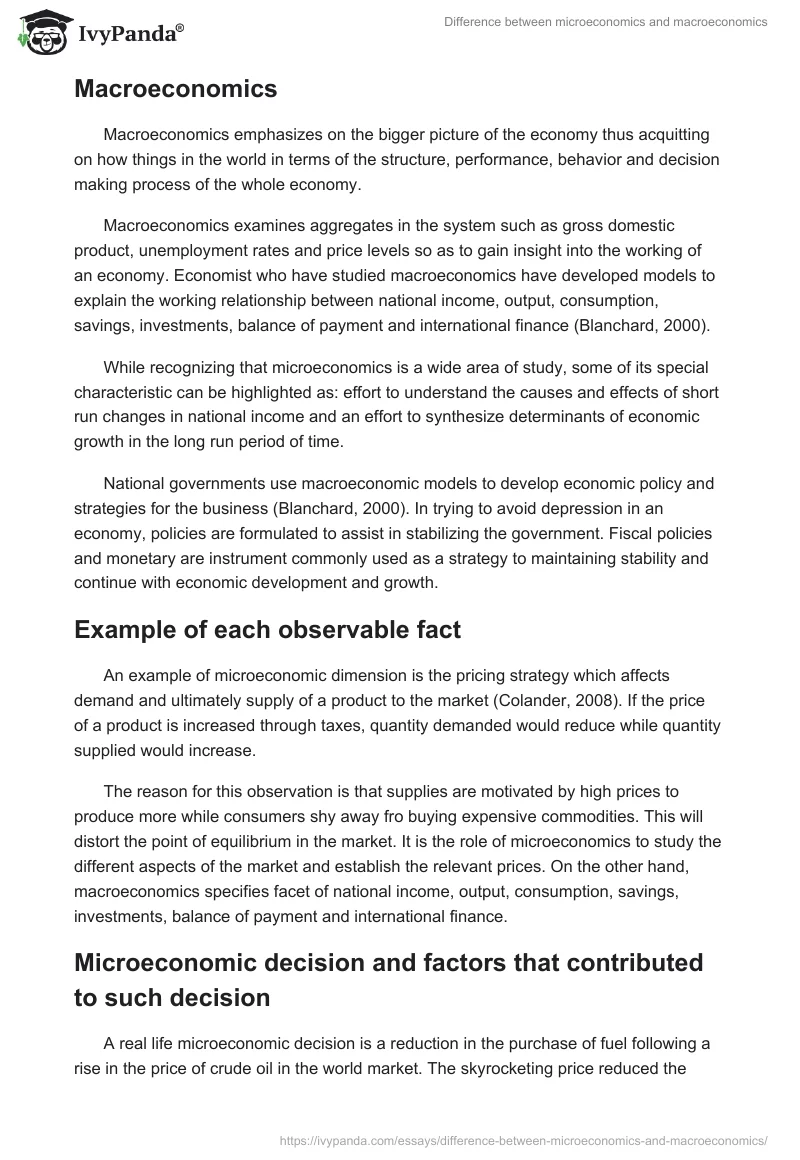Introduction
Economics is a process of making decision using scientific tools of research and analysis. This paper is a presentation of distinction between microeconomic and macroeconomics. These terms are critical in economics since they offer insight into economic discipline. Examples of each Distinctive difference between microeconomics and macroeconomics will be discussed in depth.
It will be fair to illustrate microeconomic decisions and factors that contributed to such a decision. Furthermore, macroeconomic event with its impact will be specified in the deliberation.
Difference between microeconomics and macroeconomics
Microeconomics
Microeconomics can be defined as economics that examines how persons allocate the minimum resource among the households and firms (Bade, 2001). The decisions made in the market regarding the purchase of specific goods and services affects directly or indirectly supply and demand chain. Such decisions also have an influence on the prices of products and ultimately the demand and supply.
We can note therefore that microeconomics deals with the aspects of prices and its efficiency in a market environment where decisions are made. Microeconomics revolves round production, consumption, and sale of goods and services (Colander, 2008). Some economic policies like change of taxes affect microeconomics of a country. If more tax is charged on market goods, then demand decreases. It is also in microeconomics that a market failure like monopoly is speculated.
Macroeconomics
Macroeconomics emphasizes on the bigger picture of the economy thus acquitting on how things in the world in terms of the structure, performance, behavior and decision making process of the whole economy.
Macroeconomics examines aggregates in the system such as gross domestic product, unemployment rates and price levels so as to gain insight into the working of an economy. Economist who have studied macroeconomics have developed models to explain the working relationship between national income, output, consumption, savings, investments, balance of payment and international finance (Blanchard, 2000).
While recognizing that microeconomics is a wide area of study, some of its special characteristic can be highlighted as: effort to understand the causes and effects of short run changes in national income and an effort to synthesize determinants of economic growth in the long run period of time.
National governments use macroeconomic models to develop economic policy and strategies for the business (Blanchard, 2000). In trying to avoid depression in an economy, policies are formulated to assist in stabilizing the government. Fiscal policies and monetary are instrument commonly used as a strategy to maintaining stability and continue with economic development and growth.
Example of each observable fact
An example of microeconomic dimension is the pricing strategy which affects demand and ultimately supply of a product to the market (Colander, 2008). If the price of a product is increased through taxes, quantity demanded would reduce while quantity supplied would increase.
The reason for this observation is that supplies are motivated by high prices to produce more while consumers shy away fro buying expensive commodities. This will distort the point of equilibrium in the market. It is the role of microeconomics to study the different aspects of the market and establish the relevant prices. On the other hand, macroeconomics specifies facet of national income, output, consumption, savings, investments, balance of payment and international finance.
Microeconomic decision and factors that contributed to such decision
A real life microeconomic decision is a reduction in the purchase of fuel following a rise in the price of crude oil in the world market. The skyrocketing price reduced the power of the buyer. A decision to reduce on purchase of fuel was also necessitated by inflation rates affecting consumer goods. There is a reason to meet basic wants along the Maslow hierarchy of needs. This factor contributed to a decision to cut down on demand for fuel.
Illustration of specific macroeconomic event and its impact
Fiscal policy involves increasing government expenditure and collections of revenue so as to jump start an economy (Snowdon & Vane, 2005). Expansionary fiscal policy has been employed by President Obama to deal with financial crisis. The government has to spend more on health, employment creation, tax incentive, and provision of security.
The net effect is a deficit financing. If a change in tax and government expenditure is done, its effect will be on such variables as aggregate demand, pattern of resource allocation and distribution of incomes (Snowdon & Vane, 2005). A more progressive tax bridges the gab between the haves and have not thus necessary in balancing income distribution in an economy.
Conclusion
There exist a distinct difference between microeconomics and macroeconomics both in its definition and functioning. Microeconomics examines scarce resource between competing wants in a household or a firm. A microeconomic decision regarding purchase of goods affects directly and indirectly the demand and supply.
Such decisions also have an influence on the prices of products on the other hand, macroeconomics deals with the economy as a whole while highlighting on policy instruments, national income, output, consumption, savings, investments, balance of payment and international finance. These are the features of an outward looking economy. The discussion also focused on illustration of both macroeconomics and microeconomic decisions.
References
Bade, R., & Parkin, M. (2001). Foundations of Microeconomics. London: Addison Wesley.
Blanchard, O. (2000). Macroeconomics. New Jersey: Prentice Hall.
Colander, D. (2008). Microeconomics. California: McGraw-Hill.
Snowdon, B., & Vane, H. (2005). Modern Macroeconomics: Its Origins, Development And Current State. Cheltenham: Edward Elgar Publishing.


